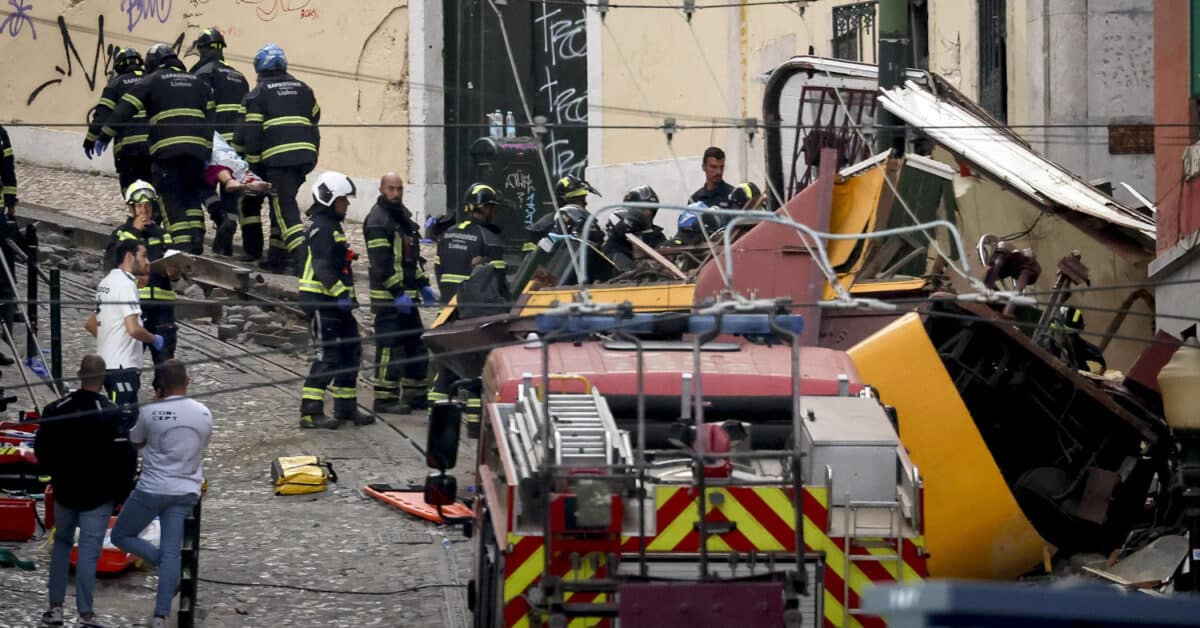Lisbon is in a state of shock on Thursday following yesterday’s serious accident on the Elevador da Glória, one of the Portuguese capital’s best-known funiculars. The accident, which occurred on Wednesday afternoon in the middle of the descent of the Calçada da Glória, left 17 people dead and around twenty injured, some of them seriously. Among the fatalities was the brakeman of the vehicle, who tried unsuccessfully to contain the onslaught.
The funicular descended out of control until it crashed violently into a building near the Place des Restaurateurs.
According to initial indications, investigated by the Portuguese Public Prosecutor’s Office, the cause may have been the breakage of the traction cable. An element that joins the two vehicles that constitute the system.
Con Trenvista Premium, disfruta de una experiencia sin anuncios y acceso a contenido exclusivo.
Únete por sólo 35€ al año y aprovecha ventajas exclusivas diseñadas para personas expertas en el ferrocarril.
★ Descubre Trenvista Premium
Outsourced maintenance from 2022
Although the company Carris, which manages Lisbon’s public transport, assures that maintenance was up to date, union representatives denounce that problems with the cable tension had already been reported lately.
Like many European transport networks, a private company maintains the funicular.
The outsourcing took place in August 2022, when Carris commissioned the maintenance service of the city’s four historic funiculars (Glória, Bica, Lavra and Santa Justa) to the Spanish company MAIN Ingeniería.
As is often the case when outsourcing, workers have long complained that maintenance is inadequate.
Although Carris claims that maintenance was up to date, the reality has once again proved those who predicted what could happen.
Unfortunately, this is not an isolated case.
A historic funicular converted into a tourist attraction
The Elevador da Glória was inaugurated in 1885 as a means of bridging the steep slope between the Baixa Pombalina and the Bairro Alto.
The line, which is 265 metres long and has gradients of up to 18%, had until yesterday two cars with wooden interiors that could hold up to 40 people. As in all funiculars, they are connected by a cable and are always at the opposite end of the route so that the weight of the one going down helps the other to go up.
Although the vehicles are not the originals from 1885, they are one century old. They were manufactured in the early 20th century in Germany by Maschinenfabrik Esslingen during the electrification of the Elevator.
Due to its usefulness and its great heritage value, it has become one of Lisbon’s most emblematic means of transport. It was originally a means of daily mobility for the people of Lisbon, but today it is mainly used for tourism.
Every year, around three million passengers use it, attracted by the charm of travelling on a century-old transport that has established itself as one of the most photographed symbols of the city, along with the yellow trams.
Impact on the city and suspension of other elevators
The Lisbon City Council immediately decreed the preventive suspension of the other three historic funiculars (Bica, Lavra and Graça), as well as three days of official mourning. This mourning has been extended to the whole of Portugal.
The other car of the Elevador da Glória (number 2), located in the lower part at the time of the cable break, was displaced a few metres and, although it did not derail, suffered some damage.
The injured people were taken to several hospitals in the capital, including Santa María, San José and San Francisco Javier, as well as health centres in the metropolitan area. During the early hours of the morning, two of those admitted in critical condition died, bringing the death toll to 17.
The catastrophe has not only hit Portuguese and foreign families, it has also wounded the historical memory of the city.
The Elevador da Glória was not only a means of transport: it was a living heritage, a survivor of another era that had withstood modernisation and remained in service as a testimony to the technical progress of the late 19th century.
Now, Lisbon not only mourns its victims, but also faces the challenge of ensuring the future safety of transport that, although historic, must operate under the strictest standards of reliability.
And it will have to assess the future of the Elevador da Glória, which could involve the construction of a replica of the crashed car or replacing it with a modern one.
